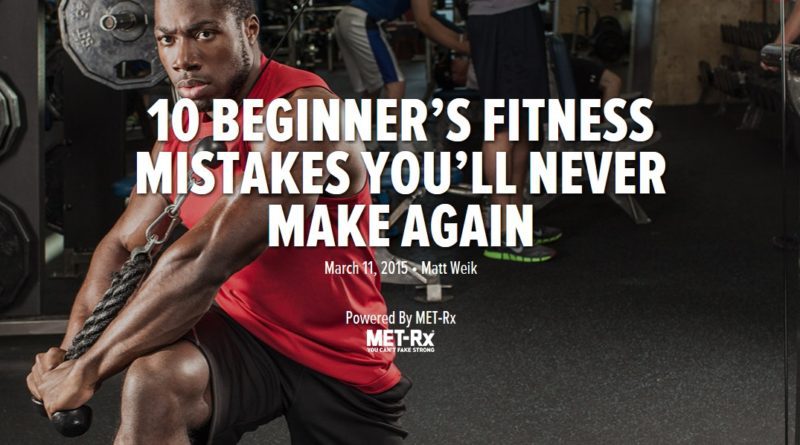10 Beginner Fitness Mistakes You’ll Never Make Again
Getting ready to transform, or just getting started in the wide world of fitness? Set off on the right foot and learn how to overcome 10 common beginner fitness mistakes most face!
I love the old saying, “If it were easy, everyone would do it.” It can be applied to countless instances in life, but it rings especially true when talking about smart exercise and proper nutrition.
It’s a great day when someone decides to buck the statistics, reject the easy path, and throw themselves into the challenge of getting strong and healthy, but that’s just the beginning. Building the foundation of a fit life takes weeks—months, even—of hard work, and your enthusiasm can often work against you.
Luckily, there’s nothing new under the fluorescent lights of the gym. Every mistake you could possibly make has been made a thousand times before, and you can learn from the past—if you’re willing. The following ten beginner fitness mistakes have dashed far too many beginners’ fitness dreams on the rocks. But not yours! This time, you’re going to recognize these beginner fitness mistakes for what they are and keep sailing right on by.

Beginner Fitness Mistakes #1: Thinking more is better
Sometimes, when people begin doing something in the gym, they immediately start looking for ways to do more. More sets, more cardio, more goals, more movements, and more time spent training might sound like things that will help you reach your fitness goals, but the opposite usually ends up being the case.
It’s understandable; you’ve made a commitment to yourself, and you want to make sure you’re doing everything you can to live up to it. Plus, if you’re like most people, you spend as much time reading about training online as you do actually training. It doesn’t take long to see the vast number of things you could be doing, but don’t take the bait!
Related Article: 6 Snacking Mistakes That Hinder Your Weight Loss
When you’re just starting out, your body will respond positively to just about any stimulus. But if you try to force it to adapt to too much at once, you’ll hit a wall or injure yourself in no time. Your body, your schedule, and your attention span can only handle so much right now. Respect all three!
The Solution: Quality over quantity. Pick a reasonable program—check out Find a Plan if you need some guidance—and follow it as closely as you can. Don’t spend more than 45 minutes in the gym per session. Your goal is to get in, do your workout, and leave. Then, come back and do it again, and again, and again.
Beginner Fitness Mistakes #2: Thinking more cardio equals more fat loss
Many beginners have weight loss—and more specifically, fat loss—as their first priority. That’s fine, but how they go about it is usually far too single-minded. Who can blame them? In most gyms, the cardio machines are the first thing you see when you walk in, and everyone who is trying to lose weight seems to be on them. You can break a sweat—while watching TV, of course—and pretend the weight room doesn’t even exist.
Related Article: 5 Mistakes You’re Making That Are Hurting Your Gains
Does low- and moderate-intensity cardio burn enough calories to help you lose fat? Sure, but it’s by no means the most efficient or effective way to achieve this goal. If you took your 45-minute window and devoted 25 minutes of it to strength training and 20 to slightly higher-intensity cardio, you would set yourself up to achieve far more dramatic results far more quickly.
The Solution: Weights for the main course, cardio for dessert. MET-Rx athlete and four-time Figure Olympia champion Nicole Wilkins says, “If you are looking to change the shape of your body, have more definition, and feel stronger, you simply must include weight training.”
Muscle burns calories at rest, meaning that for every bit you add, you become a more efficient fat-burning machine. Plus, as you get stronger, you’ll find that you can do more work—be it cardiovascular work or your normal daily work—and more work equals more calories burned. There’s simply no way around it; you need strength training in your life!
Beginner Fitness Mistakes #3: Giving up before your body has a chance to change
Transitioning from a physically inactive life to an active one is a major change, and to your body, it feels initially like a threat. Often, it can take up to 2-3 months for your body to stop fighting your new habit tooth and nail and start embracing it, in the form of muscle gain and fat loss. Unfortunately, many people give up after around 4-6 weeks—or sooner—if they aren’t seeing any major changes in their body.
Related Article: Learn from Noob Fitness Mistakes
This is no fun to hear, but it’s the truth. And, if you’re in a caloric deficit, your body’s urge to protect and preserve every calorie is going to be even greater.
The Solution: Be more stubborn than your body. Eventually your body will get the memo, respond to what you’re doing in the gym, and begin to understand it can live—and thrive—with what you are putting it through. However, “eventually” is different for each person.
Your body is a high-tech computer, but sometimes it just takes some new software and a little patience to make it run better. Once you’ve started a program or diet, give yourself at least a couple of consistent months before you make drastic changes.
Beginner Fitness Mistakes #4: Watching the scale like a hawk
The scale is the fitness world’s equivalent of the proverbial watched pot that never boils. We’ve all hopped on the scale at some point in our lives and found ourselves disappointed that even after hours in the gym, multiple times a week, for several weeks, the same number is staring up at us.
When this happens, the thought of throwing the scale through the closest window comes to mind. Well, maybe you should! The number on the scale is just that—a number. It doesn’t say anything about lean muscle mass, water weight, or body fat. Heck, even body composition doesn’t tell the whole story.
The Solution: Use other measurements of progress. It may not sound scientific, but how you look and feel are probably the best measurements of your progress when you’re just starting out. How does your clothing fit? Is it a little looser around the middle or tighter in the sleeves? Progress! What about your workouts—do they feel better? Are certain weights moving more easily? Is your overall energy level improving during the day? That’s definitely progress.
For the initial few months of your lifestyle change, trust these as your real measurements. Back them up every once in a while with progress photographs and a body composition test, and only step on the scale once in a blue moon. Most importantly, just keep going back for more. You will change!
Click here to continue reading…

Do you need content or copy for your business or website? Let me know how I can help! We also own Writing Rebels if your company is not in the health and fitness industry.
Below are some great resources:
- Lack of Content Creation Could Be Slowing Your Growth
- Why My Writing Style Caters to the Customer, Not the Client
- Content Writer vs Supplement Copywriter: Who Do You Need?
- The SEO Power of an Authoritative Content Writer
- Is Your Business Taking Advantage of Fitness Articles?
- 23 Content Marketing Statistics & Why They Should Matter to You

